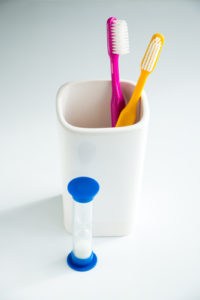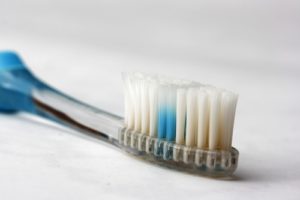You have been brushing your teeth for years. However, you likely have also been doing it wrong for years.
Most of us don’t give our teeth brushing technique much thought outside of the dental chair these days. However, we should. Experts have identified five ways most of us made mistakes brushing our teeth today. And a few of them are bound to surprise you.
Mistake #1: Failing to brush for at least two minutes.

2:00 x 2 for healthy teeth and gums
You read that right: two minutes is the recommended duration for tooth brushing. If that comes as a surprise, you are not alone. According to the Delta Dental Oral health and Well-Being Survey in 2014, most Americans brush for one minute and 52 seconds. Which is pretty awesome and definitely deserves a pat on the back. If you’re already brushing for ‘two minutes’ make sure you get that extra 8 seconds in! Dentists also recommend that you should brush at least twice a day – or 2:00 x 2.
If you’re not brushing 2:00 x 2, try the following:
- Divide the mouth into four sections (upper left, upper right, lower left, lower right) and use 30 seconds per section to address each of the surfaces of the sections (outer, inner, and chewing surfaces). And don’t forget the tongue and roof of your mouth.
- Set a timer on your smartphone to indicate when two minutes has passed.
- If you use a Sonicare®toothbrush, it will time your brushing for you. Use the indicators to move from section to section of your mouth.
- Watch TV while you are brushing to keep from getting bored.
Why don’t people brush for the full two minutes? Simply put: they get bored. However, it’s important to give your teeth the full treatment each time.
Mistake #2: Brushing with a worn-out brush.
When was the last time you replaced your toothbrush? If you don’t know, you should do it today. Experts agree that you should replace your toothbrush every three months or four months. Even if you use a sonic or electric toothbrush, you should replace the head every three or four months.
Why? Because the bristles need to be in good condition to do the best job cleaning your teeth. When they are bent outward in directions, they are worn out, and they won’t clean as effectively. The soft bristles most dentists recommend require a degree of flexibility to get into the nooks and crannies of your teeth and gums. As your toothbrush ages, the bristles don’t get in there—and the bacteria and plaque do!
 Brush maintenance is also important. Rinse out your brush after every use with water, store it upright, and allow it to air dry before the next use. Drying is critical because of the germs that collect on your toothbrush, which can number in the millions. Before you freak out and toss your toothbrush, however, know that the germs do not pose a significant threat to your health. The combination of the toothpaste and the fact the germs can’t survive outside of moisture, regular use of your toothbrush with proper maintenance shouldn’t be a cause for concern. Just be sure to toss it every three months or so!
Brush maintenance is also important. Rinse out your brush after every use with water, store it upright, and allow it to air dry before the next use. Drying is critical because of the germs that collect on your toothbrush, which can number in the millions. Before you freak out and toss your toothbrush, however, know that the germs do not pose a significant threat to your health. The combination of the toothpaste and the fact the germs can’t survive outside of moisture, regular use of your toothbrush with proper maintenance shouldn’t be a cause for concern. Just be sure to toss it every three months or so!
Mistake #3: Not starting with the most difficult to reach teeth first.
A good toothbrush can only take you so far. After all, it is simply a tool; it can only work where you put it. If you don’t put it back where the most difficult teeth to reach are, it won’t reach them. At all. The fact is in millions of cases the teeth in the back (what we refer to as the posterior teeth) are the first to decay. Is it because these teeth are weaker than the teeth in the front (anterior teeth)? Nope. It’s because the teeth in the back rarely get the same attention to detail in the brushing process that the teeth in the front get. As a result, more plaque and bacteria collect on the surfaces of the anterior teeth and begin to decay.
To correct this problem, start in the back. This tactic helps in two ways. First, you are reaching the difficult teeth in the back with the brush, a vast improvement over not at all. Second, when you start brushing your teeth, you pay more attention to your technique than when you finish brushing – particularly if you are brushing for the full two minutes. If you start in the back, then you are more likely to give the posterior teeth the attention they need!
Mistake #4: Not taking it easy on the gums and surfaces.
At first, it might seem counterintuitive to take it easy on your teeth when you are trying to get them clean. After all, isn’t scrubbing the gunk off the goal here? Yes and no. Getting the gunk off is important; scrubbing isn’t.
Most experts agree that tilting the brush at a 45-degree angle at the gum line is the way to go, to ease up on the friction at the delicate area where the gums and enamel meet. Too much pressure can contribute to the recession of the gums, particularly if gingivitis or periodontitis (gum disease) is already present there. Also, short up and down motions at a gentle pressure on the tooth surface is recommended.
The products you use are also important as far as being gentle on the teeth goes. Toothpaste with tartar control or whitening agents can be harsh on the tooth surface. In some cases, the whitening agents can grind away at the tooth structure, almost like sand paper. However, it’s not an all-or-nothing proposition. If you want to whiten your smile, consider alternating between a whitening toothpaste and a regular fluoride toothpaste to ease the wear on your teeth.
Mistake #5: Brushing right after you eat.
You probably learned that you should brush after every meal. And you should—just not right after every meal.

Brushing right after eating can wear away enamel
During meals, you make your enamel weaker by exposing it to acids. Acids can cause tooth erosion. Tooth erosion is when the enamel on your teeth wears away, exposing the dentin that is below it. When the enamel is missing, your teeth are more vulnerable to decay.
To have excellent oral hygiene, you might rush in right after breakfast and brush. However, many of us consume acids during meals. Acids are found in juices, citrus fruits, coffee, energy drinks, sugar or soda. When you expose your teeth to acid, it softens your teeth. If you brush right after consuming acids, you can brush away your valuable enamel protection, causing the damage you were trying to prevent. Experts instead recommend rinsing your mouth with water right after eating and brushing your teeth 30 minutes later.
Sources:
“Survey Finds Shortcoming in American’s Dental Health Habits.” Swww.deltadental.com. Web. 9 May 2016. < https://www.deltadental.com/Public/NewsMedia/NewsReleaseDentalSurveyFindsShortcomings_201409.jsp>.
Orenstein, Beth W. “How Often Should You Replace Your Toothbrush?” www.everydayhealth.com. 9 May 2016. < http://www.everydayhealth.com/dental-health/how-often-should-you-replace-your-toothbrush.aspx>.
“How to Brush” www.colgate.com. Web. 9 May 2016. < http://www.colgate.com/en/us/oc/oral-health/basics/brushing-and-flossing/article/how-to-brush>.
Grant, Lindsey. “9 Toothbrushing Mistakes—and how to Fix Them.” www.webmd.com. Web. 9 May 2016. < http://www.webmd.com/oral-health/features/brushing-teeth-mistakes>.
“Stop acid erosion.” www.deltadental.com. Web. 9 May 2016. < https://www.deltadentalins.com/oral_health/acid_wear.html>.


Good post. I certainly love this site. Stick with it!